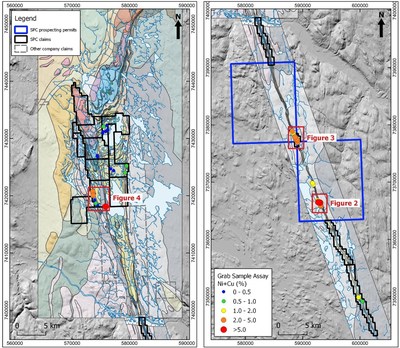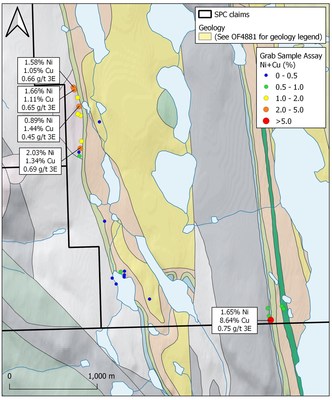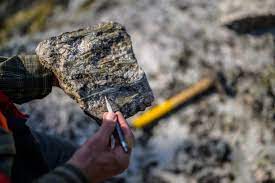Drilling News
SPC Nickel Reports High Grades Assay Results From Samples Collected on the Muskox Property, Nunavut
SPC Nickel Reports High Grades Assay Results From Samples Collected on the Muskox Property, Nunavut
Canada NewsWire
SUDBURY, ON, Oct. 5, 2022
SUDBURY, ON, Oct. 5, 2022 /CNW/ – SPC Nickel Corp. (TSXV: SPC) (“SPC Nickel” or the “Company”) is pleased …

SPC Nickel Reports High Grades Assay Results From Samples Collected on the Muskox Property, Nunavut
Canada NewsWire
SUDBURY, ON, Oct. 5, 2022
SUDBURY, ON, Oct. 5, 2022 /CNW/ – SPC Nickel Corp. (TSXV: SPC) (“SPC Nickel” or the “Company”) is pleased to announce assay results from prospecting targeting nickel-copper-platinum group metals (PGM) at the highly prospective Muskox Property (the ‘Property’) during June-July 2022. The Company’s 100% owned property consists of 14 mineral claims and 2 prospector permits covering 45,900 hectares of the Muskox Intrusion. The Property is located approximately 100 km south of the Hamlet of Kugluktuk within the Kitikmeot Region of western Nunavut.
- High-grade grab samples with values up to 1.55% Ni, 6.38% Cu and 6.18 g/t Pt+Pd+Au (PGM) were collected intermittently over a strike length of 1.0 km at the SKOX showing (refer to Figure 2 below).
- High-grade grab samples with values up to 1.48% Ni, 1.57% Cu and 2.66 g/t PGM were collected intermittently over a strike length 1.1 km at the Spider Lake Area (refer to Figure 3).
- The highest-grade sample was collected along the West Margin of the main Muskox Intrusion and returned values of 1.65% Ni and 8.64% Cu (refer to Figure 4 below).
Grab samples are preferentially selected and are not representative of the entire property.
Grant Mourre, CEO and President of SPC Nickel Corp. commented, “We are very encouraged by the results from our maiden Muskox field trip. The results further confirm our belief, that the Muskox Intrusion has the potential to become a world class Ni-Cu-PGM camp. We are excited to continue to evaluate and develop targets on the property and look forward to our return to the field.“
The Company completed a five-day prospecting program on the Muskox Property in late June. The Company’s field crews accessed the Property via daily helicopter flights based out of the Hamlet of Kugluktuk located approximately 100 km to the north of the Property.
The objectives of the program were two-fold: 1) to visit and resample many of the historic Ni-Cu-PGM showings on the property to gain a better understanding on the style and controls of sulphide mineralization; and 2) to collect high-quality geochemical data that will be used to better understand the overall prospectivity of the Muskox Intrusion. During the five-day program, a total of 140 grab samples were collected across a wide range of geological environments, this included 62 samples for assay analysis and 78 samples for complete geochemical analysis. Non-mineralized to weakly mineralized samples were intentionally collected for all sites for complete geochemical characterization. Refer to Figure 1.
Feeder Dyke (Figure 1)
The Feeder Dyke is exposed as a 60 km long, 200 to 600 metre wide dyke composed of picrite and gabbronorite in zones parallel to the dipping walls of the dyke. Zones of disseminated to massive sulphide mineralization have been identified intermittently over the length of the dyke and are commonly associated with breccia zones or flexures within the dyke like those observed at Voisey’s Bay and the Sudbury Basin.
A total of 95 samples (48 samples for assay and 47 samples for complete geochemical analysis) were collected from four selected areas along the length of the 60 km Muskox Feeder Dyke. Highlights from two areas, the SKOX/Marceau Lake and the Spider Lake Areas are presented below.
SKOX/Marceau Lake Area (Figure 2)
A total of 28 samples were collected over the SKOX/Marceau Lake Area, this includes 16 samples for assay and 12 samples for complete geochemical analysis. Refer to Table 1 for assay results.
Highlights:
- Two distinct types of sulphide mineralization were encountered at the SKOX/Marceau Lake Area.
- Type 1: Sub-rounded to rounded pods of semi-massive to massive sulphide surrounded by halos of net-textured sulphides within the gabbronorite units throughout the area. Pods can range in size from centimetres up to metres in size.
- Type 2: Disseminated to blebby Cu-PGM-rich sulphides within gabbronorite units along the western margin of the dyke, over a strike length of 1.2 km.
- Type 3: Anastomosing veins of semi-massive to massive sulphide within gabbronorite at the historic SKOX showing. Sulphide veins may be related to a zone of magmatic breccias and/or structurally controlled.
- Type 1 sulphides were found to be Cu and Ni-rich, but PGM-poor, while Type 2 and Type 3 sulphides are predominately Cu and PGM-rich.
- The SKOX showing is coincident with a VLF-EM anomaly remodelled by the Company (refer to May 24, 2022 press release) from data collected by BHP in 19941. The highly prospective anomaly has a strike length of 500 metres and a width up to 125 metres. A 2D inversion model demonstrates that the anomaly extends to at least a vertical depth of 80 metres, which is the depth limitations of the survey.
- Preliminary field observations suggest the main sulphide zone may be related to changes in the geometry of the Feeder Dyke which may cause a change in the flow regime of the magma as it flows along the conduit.
- The SKOX/Marceau Lake Area remain virtually untested with no modern geophysics or diamond drilling being completed to date.
Note: Coordinate system is NAD83 Zn11. 3E equal Pt + Pd +Au. Grab samples are preferentially selected and are not representative of the entire property.
Spider Lake Area (Figure 3)
A total of 47 samples were collected over the Spider Lake Area, this included 17 samples for assay and 30 samples for complete geochemical analysis. Refer to Table 2 for assay results.
Highlights:
- Two distinct types of sulphide mineralization were encountered at the Spider Lake Area.
- Type 1: Sub-rounded to rounded pods of semi-massive to massive sulphides surrounded by halos of net-textured sulphides within the gabbronorite units. Pods can range in size from centimetres up to metres in size.
- Type 2: Disseminated to net-textured chalcopyrite-rich sulphides within gabbronorite units.
- Type 1 sulphides were found to be Cu and Ni-rich, but PGM-poor, while Type 2 sulphides are predominately Cu and PGM-rich.
- The main showing at the Spider Lake Area consists of disseminated to net-textured sulphides (chalcopyrite dominate) that were traced over a strike length of 700 metres and were found to be sub-parallel to the internal igneous contacts.
- Preliminary field observations suggest the main sulphide zone may be related to changes in the geometry of the Feeder Dyke which may cause a change in the flow regime of the magma as it flows along the conduit.
- The Spider Lake Area remain virtually untested with no modern geophysics or diamond drilling being completed to date.
Note: Coordinate system is NAD83 Zn11. 3E equal Pt + Pd +Au. Grab samples are preferentially selected and are not representative of the entire property.
Main Muskox Intrusion (Figure 4)
The Main Intrusive is a 60 km long by up to 11 km wide elongate-shaped body that is well differentiated and consists of gently inwardly dipping layers of dunite, peridotites, pyroxenites and gabbroic rocks. The total thickness of the exposed portion of the Main Intrusion is up to 1,895 metres based on drilling completed by the Geological Survey of Canada in 1963. Within the Main Intrusion, high-grade massive Ni-Cu-PGM sulphide mineralization occurs along the basal contact of the intrusion or in the adjacent footwall, similar to the Sudbury and Norilsk camps, while narrow PGM-bearing chromite horizons occur within the upper stratigraphic units of the intrusion, similar to the Bushveld and Stillwater Intrusions.
A total of 45 samples were collected over the Main Muskox Intrusion, this included 15 samples for assay and 30 samples for complete geochemical analysis.
Highlights:
- Extensive gossan development over multiple kilometres along the western margin of the Muskox Intrusion.
- Three distinct types of sulphide mineralization were encountered along the margin of the Muskox Intrusion.
- Veins and/or irregular bodies of high-grade massive sulphide hosted within marginal gabbronorites at the intrusion-footwall contact.
- Veins and/or irregular bodies of high-grade massive sulphide hosted entirely within footwall lithologies proximal to the contact. Initial interpretations suggest that these zones represent massive sulphide that has been either fractionated or injected into the footwall, similar to what is observed at the Sudbury and Norilsk camps.
- Coarse grained blebby to net-textured sulphides within peridotite units overlying the marginal gabbronorite hosted mineralization.
Note: Coordinate system is NAD83 Zn11. 3E equal Pt + Pd +Au. Grab samples are preferentially selected and are not representative of the entire property.
The Muskox Intrusion is one of the last undeveloped camp-scale Ni-Cu-PGM prospects in the world. Originally discovered by INCO in the late 1950s during an aerial survey that discovered visible surface indications of mineralization (gossans) extending over tens of kilometres across the tundra. INCO drilled and sampled 117 shallow holes to test the gossans between 1957 and 1959 resulting in intersections of up to 7.6% Cu, 3.2% Ni and 16 g/t PGM2 over 5.48 metres. Over the next 60 years, companies including Equinox Resources Ltd (1980s), Muskox Minerals Corp. (1995), Anglo American Exploration (2003) and Silvermet Inc. (2007) completed limited exploration programs on the Muskox Intrusion.
The Muskox Intrusion is one of the largest and least deformed layered mafic to ultramafic bodies in the world. It was emplaced during a large magmatic event (Mackenzie Magmatic Event) in the Proterozoic by mantle plume volcanism related to the widespread Coppermine River Group flood basalts. The intrusion is broadly composed of two distinct, but related, components called the Main Intrusive Body and the Feeder Dyke, which combined are exposed over a length of 125 km, and range in width from 200-600 metres in the Feeder Dyke to 11 km in the Main Body of the intrusion.
|
1. |
Zaremba, C and Peregoodoff, T. 1994. 1994 Geological, Geochemical and Geophysical Report on Prospect Permits 1585 and 1586, NWT. BHP Minerals Canada Ltd., DIAND Assessment Report 083404,43 p. |
|
2. |
Page, J.W., Culbert, R.R., and Martin, L.S. 1988. Geochemical, geophysical and diamond drill reports on the Muskox property, NWT. Equinox Resources Ltd., DIAND Assessment Report 082562,56 p., 8 data Appendices. |
SPC Nickel follows rigorous sampling and analytical protocols that meet or exceed industry standards. All rock samples collected were placed in plastic sample bags and were transported back to the field camp and later to the ALS facility in Yellowknife, NWT, Canada. Sample batches include certified reference materials that are then processed under the control of ALS. All assay samples were analyzed in Vancouver by ALS. Platinum, palladium, and gold values were determined together using standard lead oxide collection fire assay and ICP-AES finish. Base metal values were determined using sodium peroxide fusion and ICP-AES finish. Silver values were determined using an aqua regia digestions and an AAS finish. All geochemistry samples were analyzed in Vancouver by ALS. Platinum, palladium, and gold values were determined together using standard lead oxide collection fire assay and ICP-AES finish. Trace elements were determined by a lithium borate fusion prior to acid dissolution and an ICP-MS analysis. Major element and base metals were determined by a four-acid digestion and an ICP-AES finish.
The technical elements of this news release have been approved by Mr. Grant Mourre, P.Geo. (PGO), CEO and President of SPC Nickel Corp. and a Qualified Person under National Instrument 43-101. The historical information shown in this news release was obtained from historical work reports filed by Equinox Resources Ltd. and BHP Minerals Canada Ltd. and have not been independently verified by a Qualified Person as defined by NI 43 101. Note that grab samples values shown in this news release are selective by nature and values reported may not be representative of mineralized zones.
SPC Nickel Corp. is a Canadian public corporation focused on exploring for Ni-Cu-PGMs within the world class Sudbury Mining Camp. The Company is currently exploring its key 100% owned exploration projects Lockerby East and Aer-Kidd both located in the heart of the historic Sudbury Mining Camp and holds an option to acquire 100% interest in the Janes Project located approximately 50 km NE of Sudbury. In addition, the Company recently acquired over 46,000 hectares covering a large proportion of the high prospective Muskox Intrusion, located in Nunavut. Although our focus is on Sudbury, we are an opportunistic company always looking for opportunities to use our skills to add shareholder value. Additional information regarding the Company and its projects can be found at www.spcnickel.com.
Except for statements of historical fact contained herein, the information in this news release constitutes “forward-looking information” within the meaning of Canadian securities law. Such forward-looking information may be identified by words such as “plans”, “proposes”, “estimates”, “intends”, “expects”, “believes”, “may”, “will” and include without limitation, statements regarding estimated capital and operating costs, expected production timeline, benefits of updated development plans, foreign exchange assumptions and regulatory approvals. There can be no assurance that such statements will prove to be accurate; actual results and future events could differ materially from such statements. Factors that could cause actual results to differ materially include, among others, metal prices, competition, risks inherent in the mining industry, and regulatory risks. Most of these factors are outside the control of the Company. Investors are cautioned not to put undue reliance on forward-looking information. Except as otherwise required by applicable securities statutes or regulation, the Company expressly disclaims any intent or obligation to update publicly forward-looking information, whether as a result of new information, future events or otherwise.
SOURCE SPC Nickel Corp.
drilling
tsxv-spc
spc-nickel-corp
spc nickel corp
press-release

Valhalla Metals reports 21 metres of 6.84% CuEq at Sun Project, Alaska
Valhalla Metals Inc. [TSXV-VMXX; OTCQB-VMXXF] reported assay results from four diamond drill holes totaling 1,104…
Capella Announces Definitive Agreement for the Sale of is Central Norway Copper-Cobalt Projects to NickelX and Financing Update
Capella Announces Definitive Agreement for the Sale of is Central Norway Copper-Cobalt Projects to NickelX and Financing Update
Canada NewsWire
VANCOUVER, BC, Oct. 17, 2023
VANCOUVER, BC, Oct. 17, 2023 /CNW/ – Capella Minerals Ltd (TSXV: CMIL) (OTC…
Canada Silver Cobalt Works Confirms Pegmatites up to 20 meters wide and 70 meters long at Sangster West
Pegmatite Confirmations and Advanced Geochemical Insights Propel Exploration Success
Coquitlam, BC – TheNewswire – October 17, 2023 – Canada Silver…
























